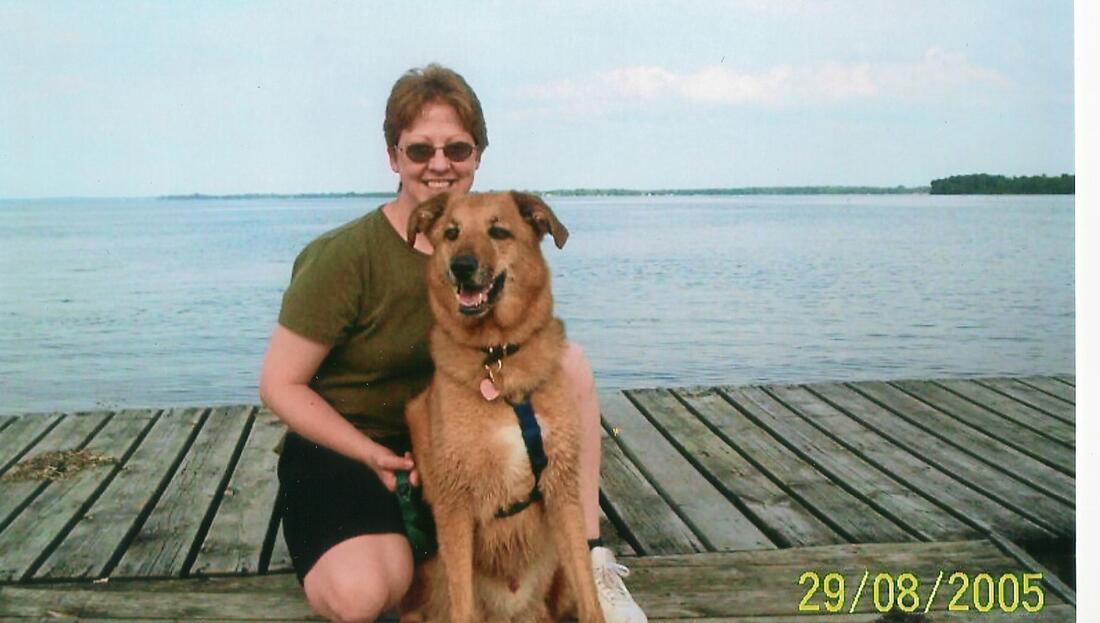|
Farley was always off leash in the backyard, day or night. There had never been a problem until the one night when his prey drive kicked in. As soon as he was let out for his last pee of the night, he quickly ran around the back of the house, out of sight and out of the light by the back door. He didn't bark or growl or make any sound. He just took off like a rocket. We couldn't see him in the dark, and he wasn't responding to a recall. When he finally came back around the corner, and into view, his face was full of porcupine quills.
Ahhhh, geez! It looked awful, and it must have been so painful. We brought him inside and tried to decide what to do with him. We'd never had a dog go after a porcupine before. Our two previous dogs, Blackie and Jake, were outside dogs, and just seemed to know not to bother wild animals. Farley was whining and whimpering. He kept pawing at his face, trying to dislodge the quills. The veterinary hospital was closed. I don't know if there were twenty-four-hour emergency veterinary clinics back then. If so, we weren't aware of them. We would have to wait until the morning to take him to the veterinary hospital. I wanted to help him and ease his pain in some way. I remembered hearing or reading that you should cut the tips of the quills to release the air and deflate them. Supposedly, this would lessen the pain for the animal. DO NOT DO THIS! Ignorance is not bliss. Not only does this make removing the quills more difficult, but it can also cause them to splinter. Cutting the quills can cause more harm than good. Unfortunately, I didn't know any better at the time. Poor Farley. He reluctantly let me do it. For the second and last time in his life, he growled at me. At that point, I stopped. I decided to let him be. He'd just told me that he'd had enough. It was a long night. He cried and whimpered throughout it. The next morning, we called the veterinary hospital and made an early appointment to have the quills removed. My sister drove, and I sat in the front passenger seat. Farley was sitting in his regular car dog position, with his rear end on the back seat, front paws on the floor, and his upper body wedged between the two front bucket seats. Finally, we were on our way to end his pain and suffering. I guess all pet owners have a phrase they say to comfort or allay the fears of their pet(s). My phrase has always been, "It's okay." I use it to help calm or reassure them. Most times, it's helpful. I should have thought about the context I was using it in. Farley had a high level of intelligence, and a distinctive personality that showed in his facial expressions. In my attempt to comfort Farley during the car ride, I said, "It's okay, Far." As he quickly turned his head to look at me, his eyes flew wide open. If looks could kill, I would have been dead on the spot. The expression on his face was a mixture of shock, dismay, and disbelief. If he could have spoken words, I imagine he would have said something to the effect of, "Are you #@%#ing, kidding me? Do you see these THINGS sticking out of my face!!!" He was right, I shouldn't have said that. I carefully watched my words after that. I comforted him as best as I could by putting my left arm around his shoulders and fought the urge to use my 'phrase'. The veterinarian sedated Far and removed the quills. Some had gone inside his mouth. Fortunately, none had gone into his eyes. All in all, he fared well after his misadventure. After that incident, a new prevention policy was put into place. After dark, Farley was on a leash and kept in the light for his nightly excursions. Although his movements were more limited, he was safe. It was a necessary part of living in a rural area. © Debra J. Bilton. All rights reserved.
0 Comments
Your comment will be posted after it is approved.
Leave a Reply. |
AuthorDebra J. Bilton: Author, blogger, lover of animals & nature, martial artist & sensei (teacher), Buddhist. Archives
May 2021
Categories |

 RSS Feed
RSS Feed
